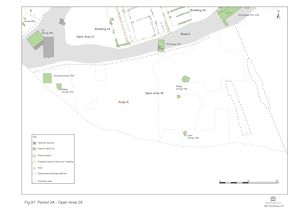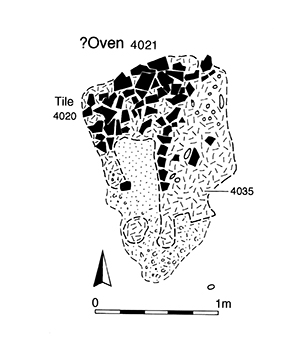
Activity in Open Area 28 that appears to date to the later 1st or earlier 2nd centuries AD includes an oven and pitting (Figure 91). Later developments within the western and eastern sides of this enclosure during Period 3 are described in the next sections. A high degree of continuity of activity from Period 2B is presumed.


The truncated remains of a tile-built structure comprises two courses of tile (4020), bonded with mortar and clay (Figure 118). The dislodged remains of further courses are represented by an overlying spread of disturbed tile (4019). The structure retains a vaguely rectangular form, some 1m by 0.9m in extent, though no tangible construction cut is discerned, possibly due to it largely overlying Period 2 pit 4117 (Group 62). Fragments of burnt clay floor (4035) survived in its interior. A function as an oven or crop-processing structure is posited, this probably being the remnants of the flue area of the structure.
Small oval pit 4148 lies in relative isolation, close to Road 3. Among other pottery sherds judged to be incidental inclusions, it contains two complete, though crushed, decorated samian bowls that are placed upright in the shallow cut. Accompanied by a Late Iron Age potin coin (SF405) and covered with a large grog-tempered vessel lid, these constitute a deliberate and structured deposit.
The majority of the investigated late 1st to early/mid-2nd century pits are located within the eastern part of OA28 (although it should be noted that its central part was not excavated).
Those few that lie within the western part (Group 753) can be demonstrated to pre-date the later Period 3 imposition of Building 39. Large pit 14006 underlies the floor of later Period 3 Building 39 and it remains possible that others also exist below this structure. Nearby pits 4733 and 4883 pre-date the fenceline Structure 27, which is conjectured to be associated with the later building.
The eastern pits largely lie within a dense inter-cut cluster of Period 2B-4 pitting that extends down alongside the perceived plot boundary. The excavated examples are positioned away from the Road 3 frontage and perhaps increasing in frequency toward the rear (south) of the plot (4136, 4163, 4337, 4526, 4616, 4982, Group 729). Two outliers, pits 4458 and 4979 (Group 755), lie to the north. However, this supposed patterning is as likely to be the product of selective excavation of the better-defined pits on the peripheries of the inter-cutting mass.
Pit diameters vary considerably between 1.2m and 3m or more, though most are relatively deep compared to those elsewhere across the settlement in Period 3 (few were under 0.6m deep, several over 1m). Finds assemblages are large and more varied than those of Period 2. Along with a generally large pottery component, modest amounts of tile and ironwork are now present. Of possible significance is the relatively large amount of animal bone, though this could merely be due to enhanced conditions of preservation within the large inter-cutting complexes. The incidence of metalworking waste such as slag, copper-alloy cast waste, crucibles and mould fragments is also noteworthy. Triangular loomweight fragments are fairly common, although the high degree of residuality demonstrated by the accompanying pottery cautions against suggesting their continued use into the Roman period.
The incidence of a probable placed deposit of a holed, but otherwise complete, storage jar inserted into the top of pit 4526 (Group 729) is notable.
Internet Archaeology is an open access journal based in the Department of Archaeology, University of York. Except where otherwise noted, content from this work may be used under the terms of the Creative Commons Attribution 3.0 (CC BY) Unported licence, which permits unrestricted use, distribution, and reproduction in any medium, provided that attribution to the author(s), the title of the work, the Internet Archaeology journal and the relevant URL/DOI are given.
Terms and Conditions | Legal Statements | Privacy Policy | Cookies Policy | Citing Internet Archaeology
Internet Archaeology content is preserved for the long term with the Archaeology Data Service. Help sustain and support open access publication by donating to our Open Access Archaeology Fund.